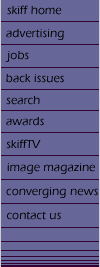 |
Friday,
February 20, 2004 |
|
|
|
|
 |
 |
Terror
alert system not clear
COMMENTARY
By
Erin Cooksley
It
seems like everyday there are news conferences about intelligence
picking up suspicious chatter and possible unspecified
threats. Usually these briefings lead to a change in the
Color-Coded Terror Alert chart. The colors green, blue,
yellow, orange and red, represent and correlate with the
increase in level of threat: low, guarded, elevated, high,
and severe, respectively.
When the color-coded chart was first established, the
level moved up and down so fast the entire nation suffered
from terror whiplash. It alarms the public with warnings
that are too vague to be useful, and besides, they never
really outlined what actions should be taken by individual
citizens when we are under each color. It became somewhat
of a joke, and every time Homeland Security Adviser Tom
Ridge warned us to be careful and Attorney General John
Ashcroft told us to stay vigilant, Home Depot had a sale
on duct tape. Then we would laugh at the story of the
government that cried wolf. I like how Brian Doherty,
the senior editor of Reason magazine, explained his view
of the Color-Coded Terror Alert: “It’s like
you should be consulting the roll of Lifesavers in your
pocket as a little mnemonic device to remind you how frightened
you’re supposed to be right now.”
Every time the level has been raised, no attacks have
followed. We are all grateful that there have been no
attacks, and we understand the old phrase “better
to be safe than sorry.” But the frequent fluctuations
in the terror alert are raising questions about the reliability
of the underlying intelligence data. The U.S. Conference
of Mayors estimates that cities spent $2.6 billion on
additional security costs since the September 11 attacks.
Most of this funding is related to ‘code orange’
overtime costs for police and other emergency personnel.
Because it does cost states and local governments hundreds
of thousands of dollars every time the alert level is
raised, I think we owe it to local governments to be more
specific when possible. These warnings actually make America
less safe, because every dollar spent on false threats
is a dollar that can’t be spent arresting an actual
threat to society such as a murderer, robber or rapist.
The solution is to replace the gimmicky color-coded system
with one based on law enforcement needs rather than political
posturing. Ridge has acknowledged the frustration of many
with the alert system and says he wants a system of specific
warnings when intelligence warrants it. Perhaps the Department
of Homeland Security could make adjustments that could
include alerts for certain regions or sectors of the economy.
It was recently reported a drill held last month found
that antibiotics in some cities could not be distributed
and administered quickly enough under a terror attack
using biological weapons. Should an actual attack of this
nature happen, it could kill thousands. A homeland security
spokeswoman declined to comment on the report.
It seems to me, effective or not, the administration is
using the color-coded chart to make sure all of the bases
are covered. If an attack were to be carried out, they
can at least say that they warned us. I will say for the
most part, it makes Americans feel safer and like the
government is watching over them. But feeling safe is
not enough for me. Like the example of the failed attack
drill above, I would rather see results from something
of that nature than assurance from a color on a chart.
Maybe the department should look into where their funding
is going and make a more responsible choice to provide
real safety instead of just covering politicians.
Erin Cooksley is a freshman political science major from
Texas City. |
|
|
|
|
|
|